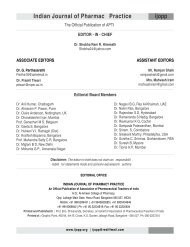Jul-Sep, 2012 - Indian Journal of Pharmacy Practice
Jul-Sep, 2012 - Indian Journal of Pharmacy Practice
Jul-Sep, 2012 - Indian Journal of Pharmacy Practice
You also want an ePaper? Increase the reach of your titles
YUMPU automatically turns print PDFs into web optimized ePapers that Google loves.
Smitha F - A Retrospective Evaluation <strong>of</strong> the Use <strong>of</strong> Thiazolidinediones in Patients with Diabetes Mellitus in a Private Hospital in Ras Al Khaimah.Rosiglitazone or Pioglitazone. The hepatic transaminases <strong>of</strong>the patients before and towards the end <strong>of</strong> the study werewithin the normal range (Table 1). Efficacy wiseRosiglitazone was able to bring down the HbA1c % comparedto Pioglitazone (Table 2).Table1: Hepatic Adverse drug reactions <strong>of</strong> ThiazolidinedionesPARAMETER ROSIGLITAZONE PIOGLITAZONEALT (SGPT) IU/LInitial 39.06 ±25.75 (n - 84) 46.61±39.78 (-15)6 Months 39.91 ±24.45 (n - 45) 40.42±31.69 (-11)AST (SGOT ) IU/LInitial 31.52±17.17 (n-31) 32.91±30.40 (n-8)6 Months 32.67±21.10 (n-11) 22.55±2.89 (n-2)ALT- Alanine aminotransferase, SGPT- serum glutamic pyruvictransaminase , AST- Aspartate amino transferase,SGOT- serum glutamic oxaloacetic transaminaseTable2: Safety and Efficacy <strong>of</strong> ThiazolidinedionesPARAMETER ROSIGLITAZONE PIOGLITAZONEHbA1c %– Initial 7.82±1.94 7.66±1.56At the End 6.92±0.99 7.74±1.86FBSInitial 168.72±55.33 188.26±67.47At the End 142.84±34.71 142.93±13.29HbA1c- Glycated hemoglobin, FBS- Fasting blood sugarDISCUSSIONThe present study was aimed to find the incidence <strong>of</strong> use <strong>of</strong>Thiazolidinediones, any association <strong>of</strong> cardiovascular andhepatic risks and comparison <strong>of</strong> the efficacy and safety <strong>of</strong>different thiazolidinediones. It was observed during the studythat majority <strong>of</strong> the patients were on rosiglitazone (n=73)compared to pioglitazone(n=17). A study conducted byBalkrishnan R comparing Rosiglitazone and Pioglitazonemonotherapy has reported that introduction <strong>of</strong> rosiglitazonewas associated with a decreased number <strong>of</strong> hospitalizations,emergency department visits, and total health care costs8compared with pioglitazone . In majority <strong>of</strong> the patients in ourstudy, the thiazolidinediones were used in combination withother antidiabetic medications and it was found thatrosiglitazone was more effective in bringing down the HbA1cvalues when compared to pioglitazone when these drugs wereused in combination with other antidiabetic drugs.Nocardiovascular adverse events were observed in any <strong>of</strong> thepatients. This could be related to the lower dose <strong>of</strong> drugs used(2-4 mg for rosiglitazone and 15-30 mg for pioglitazone) ordue to the rational or appropriate usage <strong>of</strong> the drugs. Duringthe study one patient developed pedal edema and facialpuffiness with use <strong>of</strong> Rosiglitazone. Our findings support thestudy by Mudaliar S, who has also found that bothpioglitazone and rosiglitazone have been associated withdevelopment <strong>of</strong> edema. The incidence <strong>of</strong> edema in these trialsvaried from 3.0 to 7.5% with the thiazolidinedionescompared with 1.0 to 2.5% with placebo or other oralantidiabetic therapy. Available evidence suggests that edemais a class effect <strong>of</strong> the thiazolidinediones and is multifactorial9in origin . The study by Richard WN also supports ourfindings regarding edema with usage <strong>of</strong> thiazolidinediones.According to this study, the incidence <strong>of</strong> edema was 4.8% inthe rosiglitazone group compared with 1.3% on placebo.When combined with metformin or sulfonylurea, edema wasobserved in 3 to 4% <strong>of</strong> patients compared with 1.1 to 2.2% oneither comparator drug alone. These data suggest that edemais a side effect <strong>of</strong> the TZD drugs to a similar degree, eitherwhen used as monotherapy or when combined with other oral10antidiabetes agents .There were no significant hepatic adverse effects in any <strong>of</strong> thepatients who were on Thiazolidinediones-neitherRosiglitazone nor Pioglitazone. Their liver enzymes werewithin normal range (Table 4). Our study thus is in agreementwith study by Harold E L who stated that no evidence <strong>of</strong>hepatotoxic effects was observed in studies that involved5,006 patients taking rosiglitazone as monotherapy orcombination therapy for 5,508 person years. This is inkeeping with hepatic data from clinical trials <strong>of</strong> another11member <strong>of</strong> the class, pioglitazone .Only a few case reports <strong>of</strong>hepatotoxicity have been reported in patients treated withrosiglitazone until now, with a causal relationship remaininguncertain. Furthermore, no single case <strong>of</strong> severe12hepatotoxicity has been reported yet with pioglitazone .The present study showed a better efficacy with rosiglitazone(Table 2) in reducing HbA1c %. This finding was in contrastto the report <strong>of</strong> Ronald et al where both the glitazones showedsimilar efficacy. A study showed that rosiglitazone 8 mg dailyand pioglitazone 45 mg daily brought about 1.5%improvement in HbA1c %, after 6 months <strong>of</strong> treatment. Theglycemic lowering effect <strong>of</strong> these agents is slightly less thanthat reported with sulphonylureas or metformin, yet the13durability <strong>of</strong> glycemic control is superior . Pioglitazoneshowed better improvement in the FBS levels <strong>of</strong> the patientscompared to Rosiglitazone. But the number <strong>of</strong> patients whowere on Pioglitazone was comparatively less.CONCLUSIONOur study concludes that thiazolidinediones were welltolerated in almost all the patients who were enrolled in the<strong>Indian</strong> <strong>Journal</strong> <strong>of</strong> <strong>Pharmacy</strong> <strong>Practice</strong> Volume 5 Issue 3 <strong>Jul</strong> - <strong>Sep</strong>, <strong>2012</strong> 32
















